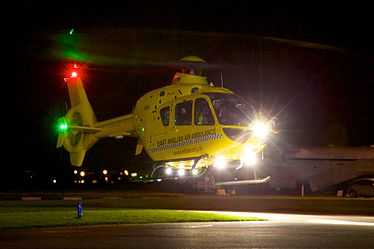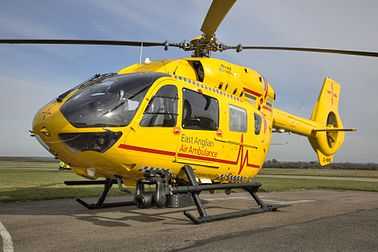East Anglian Air Ambulance
_logo.jpg) | |
| Abbreviation | EAAA |
|---|---|
| Motto | We need you today, you may need us tomorrow |
| Formation | 2000 |
| Legal status | Registered Charity No. 1083876 |
| Purpose | Dedicated helicopter emergency medical services (HEMS) provider |
| Headquarters | Norwich International Airport |
Region served | East Anglia |
| Website | EAAA |

The East Anglian Air Ambulance is an air ambulance providing Helicopter Emergency Medical Services (HEMS) across the counties of Norfolk, Suffolk, Cambridgeshire and Bedfordshire. The appeal to fund the service was launched in the summer of 2000 by top jockey Frankie Dettori, who had been a casualty in a serious plane crash a couple of months earlier. Flying commenced in January 2001 and the service was initially available only one day a week. The East Anglian Air Ambulance now operates two helicopters from its bases at Cambridge and Norwich airports, and the service now operates 365 days, covering over 5,000 square miles (13,000 km2) and a population of approximately 2.9 million.[1]
Mission
EAAA's mission statement is: "To alleviate suffering and save lives, by the rapid delivery of specialist clinicians and equipment to accidents and medical emergencies and the subsequent transfer of patients to and between hospitals".
The charity provides air ambulance cover for East Anglia, in association with East of England Ambulance Service NHS Trust, which provides highly skilled critical care paramedics who fly with the charity.
Aircraft
EAAA's first aircraft was a Bolkow 105, commissioned from Sterling Aviation. The aircraft was based at Norwich International Airport and had the call sign 'Anglia One'.
In June 2006 a new helicopter, a MBB/Kawasaki BK117, G-OEMT, was commissioned from Sterling Aviation. The aircraft replaced the Bolkow 105, G-EYNL, and went into service as Anglia One. In August 2007 and second MBB/Kawasaki BK117, G-RESC, went into service with EAAA as Anglia Two.
In March 2011 EAAA changed operator and moved from Sterling Aviation to interim supplier, Bond Air Services. Bond later successfully tendered for the contract to operate Anglia One and Anglia Two. During the interim period EAAA flew red aircraft but soon returned to their more familiar yellow livery with the introduction of the Eurocopter EC135.
In 2012 EAAA commissioned the fully night-capable EC135 T2e and commenced the CAA approval process to begin the night HEMS service.
In April 2015 EAAA received a new EC145 T2 helicopter, based at Cambridge airport. It was the first EC145 T2 to be delivered to the UK and was number 12 off the production line. The introduction of the EC145T2 provides EAAA with a helicopter that is capable of carrying two flight crew, three clinicians and a patient, whilst providing a considerable increase in cabin space and performance.
Both Anglia One and Anglia Two are fitted with the most up-to-date medical equipment and are dedicated ambulance helicopters.
Anglia One covers Norfolk and Suffolk and is based at Norwich International Airport. Anglia Two covers Bedfordshire and Cambridgeshire and is based at Cambridge Airport although both can and do fly further afield when required. EAAA works together with Essex and Herts Air Ambulance Trust to ensure there is always cover across the whole region.
Operations
When the service was first launched, Anglia One operated for only one day a week. This was soon expanded to five days a week and later to the current service of seven days a week.
Anglia Two was launched in August 2007 and began operating five days a week (from Sunday to Thursday). The service provided by Anglia Two was extended to seven days a week in 2008. It was manned by the Emergency Medical Team from Magpas Helimedix 24/7[2] and based at RAF Wyton until its move to Cambridge Airport. Clinical governance is provided by EMSC.[3]

Typical incidents for which the assistance of the air ambulance is requested include road traffic collisions, horse riding accidents, cardiac arrests and serious falls. The EAAA team of highly skilled doctors and critical care paramedics also treat many people injured in agricultural, industrial and sporting accidents.
Airlifted patients are most likely to go to the major trauma centre at Addenbrooke's Hospital, the specialist burns unit in Broomfield Hospital, Chelmsford or the Norfolk and Norwich Hospital.
In May 2013, EAAA was the first commercial air ambulance charity in England to receive approval to fly night time HEMS missions. The first team was available and ready to fly on 24 May and was called that night to a traffic collision in Essex. The clinicians were flown to the scene were they treated an injured motorcyclist with the aid of night vision equipment. The patient was then flown back to Cambridge where he was taken to the Major Trauma Centre at Addenbrooke's Hospital.
Aircrew
For the majority of call-outs each East Anglian Air Ambulance will carry a crew of three; one pilot, one critical care paramedic and one doctor (usually a specialist in emergency medicine or anaesthetics).
The EAAA crew with their expertise and training are able to 'take the hospital emergency room to the patient'. The speed in which EAAA helicopters can reach people suffering a medical emergency or accident is critical in ensuring a good recovery for the patient. EAAA can provide at the scene of the incident just about all the procedures that would be expected in a hospital. For that reason, once the EAAA doctor and paramedic crew have treated the patient, it is often safe for them to then travel on to the hospital for further treatment by road. EAAA fly approximately a third of their patients and this is either because of the critical nature of their condition or the remoteness of the incident.

Control decision
The control centre for East Anglian Air Ambulance tasking is located in Chelmsford and is staffed twenty four hours a day, every day of the year by an East of England Ambulance Service NHS Trust dispatcher and a critical care paramedic. They know what to look for in an emergency call and can ensure that the helicopter is mobilised when its life-saving services are required. The decision is made by the doctor at the scene of the incident as to whether the patient should go by land ambulance, or be flown to hospital on the air ambulance.
Finances
The East Anglian Air Ambulance is a charitable service and does not receive funding from the government. It is estimated that it costs £8.6m for 2014 [4] to keep both helicopters and the service operational; this money comes entirely from public donations and fundraising activities, including the purchase of weekly lottery tickets, corporate donations and legacy giving.
Facts and figures
- East Anglian Air Ambulance has attended over 16,000 life-saving missions since the charity's first aircraft was launched in 2000.
- The average cost of each mission flown as of 2013 - 2014 financial accounts is £2,800
- The normal cruising speed for an EAAA helicopter is 135 knots (150 mph)
- EAAA aircraft can reach patients anywhere in the region within 25 minutes
- EAAA has a charity shop based in Ipswich which is currently being refurbished
See also
- Air Ambulances in the United Kingdom
References
- ↑ East Anglian Air Ambulance - About Us
- ↑ Lift off for Bedfordshire Air Ambulance, East of England Ambulance Service, retrieved 2010-10-18
- ↑ http://www.eaaa.org.uk/news.asp?id=145
- ↑ East Anglian Air Ambulance - Helicopter Technical Information
External links
| Wikimedia Commons has media related to East Anglian Air Ambulance. |